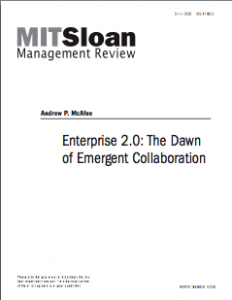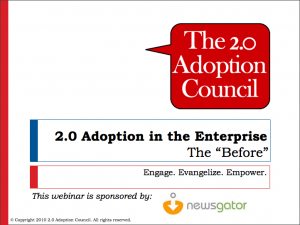Rumors surrounding the death of adoption have been greatly exaggerated.
The 2.0 Enterprisey crowd is gearing up to head to Boston for our annual pilgrimage. This will be my fourth conference as a participant and board member. Having watched and often interpreted the trends in this sector, I find it interesting to report that things have not changed much in general since our first get-together in 2007. While it’s true that we have many, many more organizations large and small experimenting with and committing to 2.0 strategies– internally and externally– and the business itself is morphing into something much more grand and all-encompassing, the truth of the matter is: we are still early adopters of this new way of working.
The notion of “adoption” in general occasionally gets called into criticism by bloggers who are looking at the phenomenon purely through the lens of new technology adoption. The adoption phenomenon is much more far-reaching and encompasses a wholesale reinvention of the way we will work in the future. Social data and social layers that will filter transactions in the enterprise are the Next Big Thing in enterprise. Period. But before we can get there, we need to on-ramp legions of employees to change their attitudes and behaviors to maximize the benefits of what the socially connected universe offers.
It’s easy for us who spend a lot of time on the social web to re-imagine where we are in real terms relative to widespread embrace of social strategy and tactical best practices. This is a mistake, and we need to scale back our expectations and see the immediate opportunity for what it is: an early adopter market. This reality has been difficult to swallow, perhaps especially for me. We’ve kicked off our case study series and early indicators are reinforcing the relative immaturity of the market. We’ll have more details on those in upcoming months. The good news is: we are all really early on a phenomenon that is changing the world as we know it. This social transformation will be larger and more comprehensive than any technology transformation (including the Internet and mobile) we’ve seen thus far. Those of us who are in this for the long haul know this instinctively and welcome the opportunity to shape the future.
That said, the Council members (who are squarely on the front lines of galvanizing change) have been working hard to put  together some thinking on what’s working and what’s not on the Adoption Trail. In addition to our full-day workshop, we have an entire track devoted to adoption issues at the conference this year. I invite you to hear directly from these customers– at their sessions, at lunch, at the bar, in the halls… wherever they are. You’ll know them because they’ll be wearing our pins, as well as a star on their badges. We have over 30 Council members attending from a variety of industry sectors including: IT/High Tech, Telecommunications, Pharmaceuticals, Public Utilities, Government, Construction, Publishing, Retail, Non-Profit, Health Care, Financial Services, and Manufacturing.
together some thinking on what’s working and what’s not on the Adoption Trail. In addition to our full-day workshop, we have an entire track devoted to adoption issues at the conference this year. I invite you to hear directly from these customers– at their sessions, at lunch, at the bar, in the halls… wherever they are. You’ll know them because they’ll be wearing our pins, as well as a star on their badges. We have over 30 Council members attending from a variety of industry sectors including: IT/High Tech, Telecommunications, Pharmaceuticals, Public Utilities, Government, Construction, Publishing, Retail, Non-Profit, Health Care, Financial Services, and Manufacturing.
On the last day of the conference, in the last session time slot, I’ve reserved time to discuss “what we missed” in our agenda planning. As board members, we try hard to include everything topical that’s fit to present, but invariably, we could fall short and miss or underplay something important. This session is an attempt to capture that lost content and discuss it with a panel of customers and industry thought leaders (including Dennis Howlett and Lee Bryant, as well as a team of sharp shooter Council members). So, while you’re attending sessions, please keep a mental note of anything you feel has been missing from the dialog all week and bring it to the session. We’re going to try and keep the session as interactive as possible.
Look forward to seeing you all in Boston.




